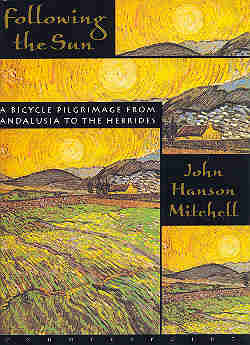Following the Sun
John Hanson Mitchell

“I'd hoped to get in shape for my bicycle trip, but I never did get around to taking the long practice rides that I had intended to take before leaving. As a result, not four hours into my pilgrimage, I began to feel my muscles tightening. I wasn't worried, though, having no particular schedule in fact I calculated that if I got to Puerto de Santa María and I liked it, I might as well stay there. So I pedaled slowly through the pastoral landscape, stopping often to look at frogs or birds, and in due time came to what seemed to me a fine overlook, an ancient ruin with crumbling arches just beyond a gully. I was leaning against my bicycle looking at the ruin when a small falcon shot over my head and flew straight into one of the arches, so I wheeled my bike up a narrow sand road and came to a grassy spot among the olive trees and sat down to watch.
In a minute or two the falcon flew out again; clearly it had a nest in among the broken crevices. This seemed a propitious sign for this journey. In the ancient Egyptian cosmology, the sun god Ra would often appear in the form of a falcon. It was he, Horus, the falcon, who represented one of the visible forms of Atum, the first creator.”
This passage is taken from early in Following the Sun, John Hanson Mitchell's account of a bicycle trip he undertook some years ago. Subtitled “A Bicycle Pilgrimage from Andalusia to the Hebrides,” the story of his trip encompasses a wide variety of locales, foods, locals, customs, and legends – in short, a veritable buffet of armchair travel for those of us who will never undertake such a journey.Later in his trip, having made it to England, Mitchell writes:
“I spent the whole morning sitting amidst the ruins of this mysterious circle of stones and then rode up to the lesser-known archeological site known as Woodhenge, which may have served as a temple or meeting hall for the people engaged in the construction of Stonehenge. Here I lounged in the sun and ate lunch, watching the skylarks rise and flutter in the spring sky and thinking of Shelley and Keats, and romantic English springtime, rather than the ancient days of the Druids. The day was still clear and fresh, and all the fields had a deep, rain-washed English green case, and although the air was cooler, the sun was warm on my face.”
Toward the end of his book, Mitchell writes thus:
“In the later engravings and artifacts of the Picts, and also among the early Scottish Christians, the solar emblem evolved, as it did elsewhere, into the wheel and halo symbol that is so often associated with Christ and Christian saints. Even here, in the rain-swept cloudy Highlands and all across cloudy northern Europe, the sun in prehistory maintained as much symbolic power as it did in more southerly climes.”
Though you may never make such a trip yourself, you can enjoy this author's journey. Mitchell's tale of his bicycle pilgrimage is marvelous, joyous, and light-filled. Be sure to read all about it!
All Rights Reserved.